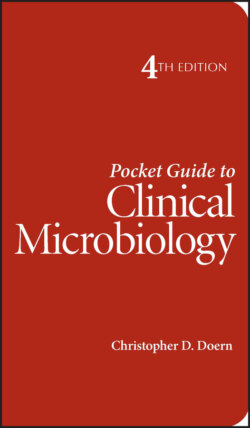Читать книгу Pocket Guide to Clinical Microbiology - Christopher D. Doern - Страница 3
List of tables
Оглавление1 Section 2Table 2.1 Human indigenous floraαTable 2.2 Arthropod vectors of medically important diseasesαTable 2.3 Fungal pathogens and geographic distributionTable 2.4 Parasitic pathogens and geographic distribution
2 Section 3Table 3.1 Bacteriology: Collection and transport guidelinesa,bTable 3.2 Specimen collection and transport guidelines for infrequently encounte...Table 3.3 Guidelines for collection of specimens for anaerobic cultureaTable 3.4 Recommended blood volumes to collect for blood culturesaTable 3.5 Mycology: Collection and transport guidelinesa,bTable 3.6 Parasitology: Specimen guidelinesaTable 3.7 Guidelines for processing stool specimens for parasitesa,b
3 Section 4Table 4.1 Detection methods from clinical specimens for clinically relevant bact...Table 4.2 Recommendations for Gram stain and plating mediaa,bTable 4.3 Screening specimens for routine bacterial cultureaTable 4.4 Processing specimens for mycobacterial identificationTable 4.5 Differential characteristics of catalase-positive Gram-positive cocciTable 4.6 Differential characteristics of most common clinically significant Sta...Table 4.7 Differential characteristics of catalase-negative Gram-positive cocciTable 4.8 Differential characteristics of beta-hemolytic streptococciaTable 4.9 Differential characteristics of viridans streptococciTable 4.10 Differential characteristics of common Enterococcus speciesTable 4.11 Differential characteristics of Gram-positive rodsTable 4.12 Differential characteristics of common Corynebacterium speciesTable 4.13 Differential characteristics of selected coryneform bacteriaTable 4.14 Differential characteristics of selected Bacillus species and related...Table 4.15 Differential characteristics of selected actinomycetesa,bTable 4.16 Differential characteristics of selected Nocardia speciesaTable 4.17 Differential characteristics of select, slow-growing Mycobacterium sp...Table 4.18 Differential characteristics of clinically relevant, rapidly growing,...Table 4.19 Differential characteristics of medically relevant Neisseria speciesTable 4.20 Differential characteristics of selected members of the Neisseriaceae...Table 4.21 Differential characteristics of selected Aggregatibacter, Actinobacil...Table 4.22 Differential characteristics of selected Capnocytophaga, Dysgonomonas...Table 4.23 Differential characteristics of Haemophilus speciesTable 4.24 Differential characteristics of selected members of the Enterobacteri...Table 4.25 Differential characteristics of Citrobacter speciesaTable 4.26 Differential characteristics of select Enterobacter, Pluralibacter, C...Table 4.27 Differential characteristics of Klebsiella and Raoultella speciesaTable 4.28 Differential characteristics of Proteus, Providencia, and Morganella ...Table 4.29 Differential characteristics of Yersinia species after incubation at ...Table 4.30 Differential characteristics of Aeromonas speciesaTable 4.31 Differential characteristics of Vibrio speciesaTable 4.32 Differential characteristics of Pseudomonas speciesaTable 4.33 Differential characteristics of Acidovorax, Brevundimonas, Delftia, C...Table 4.34 Differential characteristics of selected Bordetella speciesTable 4.35 Differential characteristics of selected oxidase-negative, oxidative,...Table 4.36 Differential characteristics of selected oxidase-positive, nonferment...Table 4.37 Differential characteristics of selected oxidase-positive, nonoxidati...Table 4.38 Differential characteristics of selected Campylobacter, Arcobacter, a...Table 4.39 Differential characteristics of select non-spore-forming, anaerobic, ...Table 4.40 Differential characteristics of selected Clostridium speciesTable 4.41 Differential characteristics of anaerobic Gram-negative bacteriaTable 4.42 Differential characteristics of the Bacteroides fragilis group
4 Section 5Table 5.1 Detection methods for virusesaTable 5.2 Cells used for viral isolationaTable 5.3 EBV serologic profiles under different conditionsa,bTable 5.4 Hepatitis B virus markers in different stages of infection and convale...Table 5.5 Clinical diseases of parvovirus B19 and method of diagnosisa
5 Section 6Table 6.1 Methods for the identification of fungiTable 6.2 Characteristic fungal elements seen by direct examination of clinical ...Table 6.3 Mycology plating guideTable 6.4 Cultural and biochemical characteristics of yeasts frequently isolated...Table 6.5 Characteristics of selected Trichosporon speciesaTable 6.6 Characteristics of Aspergillus speciesaTable 6.7 Opportunistic moniliaceous fungiaTable 6.8 ZygomycetesaTable 6.9 Dimorphic moldsaTable 6.10 Characteristics of common Trichophyton speciesaTable 6.11 Epidermophyton floccosum and common Microsporum speciesaTable 6.12 Dematiaceous fungi with macroconidia or other structuresaTable 6.13 Dematiaceous fungi with small conidiaaTable 6.14 Differentiation of Cladosporium and Cladophialophora speciesaTable 6.15 Scedosporium and Dactylaria speciesa
6 Section 7Table 7.1 Detection methods for parasitesaTable 7.2 Trophozoites of common intestinal amebaeaTable 7.3 Cysts of common intestinal amebaeaTable 7.4 Trophozoites of flagellatesaTable 7.5 Cysts of flagellatesaTable 7.6 Morphological characteristics of ciliates, coccidia, microsporidia, an...Table 7.7 Morphological characteristics of protozoa found in bloodaTable 7.8 Morphological characteristics of blood and tissue nematodesTable 7.9 Morphological characteristics of helminthsa
7 Section 8Table 8.1 Recommended pediatric immunization scheduleaTable 8.2 Recommended adult immunization scheduleaTable 8.3 Clinical and Laboratory Standards Institute (CLSI) documents related t...Table 8.4 Summary of CLSI antimicrobial susceptibility test methods for select b...Table 8.5 Routes of administration and drug class for select antimicrobial agent...Table 8.6 Routes of administration and drug class for select antifungal agentsTable 8.7 Routes of administration and drug class for select antiparasitic agent...Table 8.8 Antibacterial agents for specific bacteriaTable 8.9 Intrinsic resistance of selected Gram-negative bacteriaaTable 8.10 Intrinsic resistance of selected Gram positive bacteriaaTable 8.11 Important mechanisms of multidrug resistance in bacteria.Table 8.12 Organisms included in CLSI and EUCAST breakpoint tablesTable 8.13 Guide to interpretive criteria for select organisms for commonly test...Table 8.14 Summary of MALDI-TOF MS identification of bacteria, mycobacteria, and...Table 8.15 Gene sequencing targets for organism identificationa
